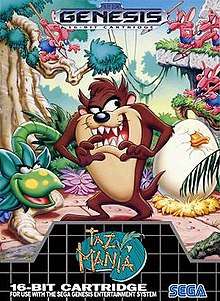Taz-Mania (video game)
| Taz-Mania | |
|---|---|
 North American Sega Genesis box art | |
| Developer(s) |
Recreational Brainware (MD) NuFX (GG) Technical Wave (MS) Visual Concepts (SNES) David A. Palmer Productions (GB) Beam Software (GB) |
| Publisher(s) |
Sega (MD, GG, MS) Sunsoft (SNES, GB) THQ (GB) |
| Platform(s) | Mega Drive/Genesis, Master System, Game Gear, Game Boy, Super Nintendo Entertainment System |
| Release |
Mega Drive Master System
Super Nintendo |
| Genre(s) | Action, Adventure |
| Mode(s) | Single-player |
Taz Mania is the name of several video games based on the Taz-Mania cartoon series. A 2D side-scrolling platform/adventure video game developed by Recreational Brainware and published by Sega on the Sega Mega Drive/Genesis in 1992. Different games were also developed by NuFX and released on the Game Gear and by Technical Wave on the Master System. Other different Taz-Mania games were also published by Sunsoft and released on the SNES and 2 games on the Game Boy were made too. One from David A. Palmer Productions and published by Sunsoft and another from Beam Software and published by THQ.
Plot
The plot of the game was actually a twist on the usual "Save the World" story setting for many platform/adventure games. One evening, Hugh Tazmanian Devil was telling his three children (Taz, his sister Molly and his brother Jake) an intriguing tale: Once there were huge giant seabirds that laid giant eggs which could feed a family of Tazmanian devils for over a year. There are also legends that somewhere along the island of Tasmania, there is a Lost Valley, where the giant seabirds still nest. Taz becomes fascinated by the prospect of the potentially large omelet and leaves in search for one of those giant eggs. Thus, the player must direct Taz across various stages in search for the Lost Valley and its Giant Bird.
Gameplay
Players control Taz as he searches for the giant egg. Taz is able to jump, spin into a tornado and eat various objects. Spinning into a tornado allows Taz to defeat most enemies, as well as gain extra jump distance, knock away items and get past certain obstacles unharmed. Taz has the ability to eat most, if not all items throughout the level, such as health recovering food items, extra lives and continues. Eating some chilli peppers allows Taz to breathe fire in order to defeat stronger enemies, while eating a star grants Taz temporary invincibility. Other items, such as bombs and weed killer can be thrown at enemies, but will damage Taz if he eats them.
Development
Recreational Brainware was led by 2 programmers – Burt Sloane and Jonathan Miller and was based in San Francisco. A semi-sequel to this game in design and concept but unrelated to the Taz-Mania cartoon series was also developed and released by Sega on the same platforms in between 1994 and 1996, entitled Taz in Escape from Mars. An official sequel titled Taz-Mania 2 was planned with an isometric viewpoint, but was never put into development.[1]
Reception
| Reception | ||||||||
|---|---|---|---|---|---|---|---|---|
| ||||||||
The Mega Drive version was a bestseller in the UK for 2 months.[4] Mega placed the game at #19 in their Top Mega Drive Games of All Time.[5]
Entertainment Weekly gave the game a B and wrote that "In Taz-Mania, starring that cartoon temper tantrum the Tasmanian devil, kids spin and stomp their ways through seven perilous stages, all animated in top-notch Warner Bros. style. Trouble is, Taz-Mania's slobbering, incoherent hero shines only when he's paired with an intelligent foil. Left on his own here, Taz seems stranded. And this game's high frustration quotient — it took me 26 tries before I could make it to the second stage — will have even well-behaved kids doing their own Taz imitation in no time."[6]
References
- ↑ "DHNN Sunsoft". GameFan. Vol. 2 no. 3. February 1994. p. 26.
- ↑ MegaTech rating, EMAP, issue 5, page 78, May 1992
- ↑ http://www.outofprintarchive.com/articles/reviews/MegaDrive/Taz_Mania-SegaPower33-2.html
- ↑ Official Gallup UK Mega Drive sales chart, October 1992, published in Mega (magazine) issue 1
- ↑ Mega magazine issue 1, page 76, Future Publishing, Oct 1992
- ↑ https://ew.com/article/1992/08/07/latest-videogames-reviewed/
External links